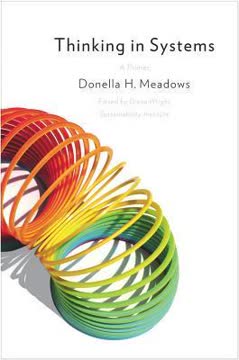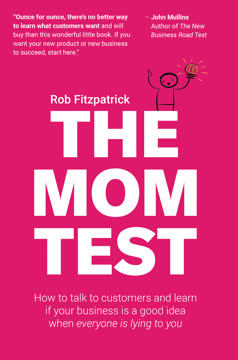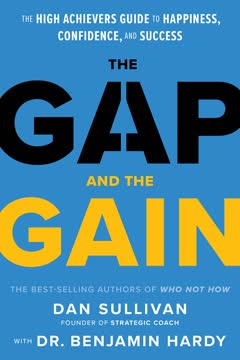Key Takeaways
1. Storytelling is the most powerful tool for inspiring change and connection
The most powerful person in the world is the storyteller. The storyteller sets the vision, values, and agenda of an entire generation that is to come.
Stories move people. Throughout history, stories have been used to share knowledge, inspire action, and shape culture. They tap into our emotions and experiences in a way that raw facts and data cannot. When information is embedded in a story, people are 22 times more likely to remember it compared to facts alone.
Stories create change. By presenting characters who undergo transformation, stories allow audiences to experience that change vicariously. This process, called neural coupling, causes the listener's brain activity to mirror the storyteller's, creating empathy and inspiring personal growth. Great stories in business, politics, and entertainment all leverage this power to move people to action.
Connection through storytelling. Stories build authentic connections between people, brands, and ideas. They give voice to shared values and desires, creating a sense of community and shared purpose. In an increasingly digital and distracted world, storytelling remains a uniquely human way to cut through the noise and create lasting impact.
2. A great hook captures attention in seconds and sets up the story
You have eight seconds to convince people that you've got something worth hearing about before they zone out, tune out, or check out.
Grab attention quickly. In today's fast-paced world, attention spans are short. A compelling hook in the first few seconds is crucial to engage your audience. This could be:
- An intriguing question
- A surprising statistic
- A vivid image or scene
- A provocative statement
Set up the story. The hook should not only capture attention but also introduce the key elements of your story:
- Who is the main character or hero?
- What is their goal or desire?
- What obstacle or conflict do they face?
Create curiosity. A great hook leaves the audience wanting more. It raises questions in their mind that compel them to keep listening or reading to find out what happens next. This emotional investment is key to maintaining engagement throughout the story.
3. Character transformation is key to engaging and inspiring audiences
While a great hook catches our attention, the promise of change brings us to the edge of our seats.
Change drives engagement. Audiences are drawn to stories of transformation. We are inherently interested in how people (or characters) grow, learn, and overcome challenges. This mirrors our own desires for personal growth and improvement.
The character arc. A well-crafted character arc shows the progression from who the character was at the beginning to who they become by the end. This journey typically involves:
- An initial state or flaw
- Challenges that test the character
- Growth and change in response to those challenges
- A final state that demonstrates transformation
Inspiring change in the audience. When audiences witness a character's transformation, it inspires them to consider changes in their own lives. This is why stories are so effective for motivating action, whether in personal development, business, or social causes.
4. Universal themes and knowing your audience create deeper connections
You may have an amazing hook and characters who face change, but if the audience can't relate to your story, they won't listen or care.
Universal themes resonate. Certain themes transcend cultural and personal differences, allowing stories to connect with a wide audience. These include:
- Love and belonging
- Safety and security
- Freedom and spontaneity
- Power and responsibility
- Fun and playfulness
- Awareness and understanding
Know your audience. While universal themes are powerful, tailoring your story to your specific audience deepens the connection. Consider:
- Demographics (age, gender, culture)
- Values and beliefs
- Challenges and desires
- Prior knowledge and experiences
Research and empathy. To truly connect with your audience, invest time in understanding them. This might involve:
- Formal market research
- Informal conversations and observations
- Personal experiences and immersion in the audience's world
- Gathering feedback and adjusting your approach
5. Authenticity and vulnerability are essential for impactful storytelling
Be warned—while I've laid out some of the basic principles of storytelling in the first few chapters, without authenticity woven into your story, your message will lack the magic that moves people to engage with you and your company.
Authenticity creates trust. When stories come from a place of genuine experience and emotion, audiences can sense it. This builds credibility and fosters a deeper connection. Avoid being overly polished or perfect; instead, share real struggles and imperfections.
Vulnerability builds empathy. Sharing personal challenges, failures, and growth moments allows the audience to see themselves in your story. This creates a powerful emotional bond and makes your message more memorable and impactful.
Show, don't tell. Instead of explicitly stating the moral or message of your story, allow the audience to discover it through the characters' experiences. This active engagement leads to stronger internalization of the message.
6. Story structure provides a framework for effective narrative
From Homer to Shakespeare to Spielberg, great storytellers have all paid attention to story structure, and you should too.
The power of structure. A well-structured story guides the audience through an emotional journey, maintaining engagement and building toward a satisfying conclusion. The basic three-act structure includes:
- Setup (beginning)
- Confrontation (middle)
- Resolution (end)
Six story stages. For a more detailed approach, consider these stages:
- Exposition: Introduce the characters and setting
- Inciting Incident: The event that sets the story in motion
- Progressive Complications: Escalating challenges
- Crisis: The moment of ultimate decision
- Climax: The highest point of tension and action
- Resolution: Tying up loose ends and showing the aftermath
The story spine. For a quick and easy way to structure a story, use this template:
- Once upon a time...
- And every day...
- Until one day...
- And because of that...
- And because of that...
- Until finally...
- And since that day...
7. Heroes and supporting characters drive emotional investment
People read, watch, and tell stories not because they are enthralled with the story structure, but because they are invested in what will happen to the characters in the story. This is the emotional juice that fuels a story.
The power of the hero. Audiences naturally connect with the main character or hero of a story. This connection allows them to vicariously experience the hero's journey, learning and growing along with them. Key aspects of a compelling hero include:
- Clear goals and motivations
- Relatable flaws and challenges
- Growth and transformation throughout the story
Supporting cast creates depth. While the hero is central, a rich supporting cast adds depth and interest to the story. Common character archetypes include:
- The Mentor: Guides and equips the hero
- Allies: Help the hero overcome obstacles
- The Trickster: Challenges the status quo
- The Shadow/Villain: Creates conflict and opposition
Characters in business storytelling. When using storytelling in business, consider casting your customer as the hero, with your company or product playing a supporting role (e.g., mentor or ally) in helping them achieve their goals.
8. Creating an environment that fosters creativity leads to innovation
Whether you work in entertainment or business or any other field, you want a workplace that inspires creativity and supports innovation—and teammates who understand, support, and motivate one another.
Physical environment matters. The design of your workspace can significantly impact creativity and collaboration. Consider:
- Open spaces that encourage interaction
- Personal touches that reflect individual personalities
- Areas for both focused work and casual conversation
Eliminate fear of failure. Innovation requires taking risks and learning from mistakes. Foster a culture where:
- New ideas are welcomed and encouraged
- Failure is seen as a learning opportunity
- Experimentation is valued over perfection
Encourage diverse perspectives. True innovation often comes from the collision of different ideas and viewpoints. Create an environment where:
- Team members feel safe sharing unconventional ideas
- Cross-pollination between departments is encouraged
- Diverse backgrounds and experiences are valued and sought after
Last updated:
FAQ
1. What is "The Best Story Wins" by Matthew Luhn about?
- Hollywood Storytelling for Business: The book teaches how to apply Hollywood storytelling techniques, especially those used at Pixar, to business, branding, leadership, and communication.
- Personal and Professional Transformation: Luhn shares his journey from a family toy store to Pixar, illustrating how stories can inspire change and action in both individuals and organizations.
- Practical Storytelling Frameworks: The book provides actionable frameworks, such as hooks, loglines, character arcs, and story structure, to help readers craft compelling stories for any audience.
- Emphasis on Authenticity and Connection: Luhn stresses the importance of authenticity, emotional connection, and understanding your audience to make stories memorable and impactful.
2. Why should I read "The Best Story Wins" by Matthew Luhn?
- Proven Pixar Insights: Learn storytelling secrets from a veteran Pixar story artist and writer who contributed to films like Toy Story, Monsters Inc., and Finding Nemo.
- Business and Leadership Applications: The book translates Hollywood storytelling into practical tools for branding, marketing, sales, leadership, and team building.
- Actionable Advice: Luhn offers step-by-step methods, exercises, and real-world examples to help anyone become a better storyteller, regardless of industry.
- Inspiration and Entertainment: The book is filled with engaging anecdotes, humor, and personal stories that make learning about storytelling enjoyable and relatable.
3. What are the key takeaways from "The Best Story Wins" by Matthew Luhn?
- Story is King: Great stories are the most effective way to connect, persuade, and inspire action, whether in entertainment or business.
- Hook Your Audience Quickly: You have about eight seconds to grab attention—use unusual, unexpected, or conflict-driven hooks.
- Character Transformation Drives Engagement: Audiences are drawn to stories where characters change, face obstacles, and grow—this creates empathy and inspiration.
- Authenticity Matters: Vulnerability, honesty, and personal experience make stories believable and memorable.
- Structure is Essential: Every story needs a clear beginning, middle, and end, following proven frameworks like the six-stage story structure or the story spine.
4. How does Matthew Luhn define and use the concept of a "hook" in storytelling?
- Eight-Second Rule: Luhn emphasizes that you have only eight seconds to capture your audience’s attention, making the hook critical.
- Types of Hooks: Effective hooks are unusual, unexpected, action-driven, or present a clear conflict—often framed as a "what if" question.
- Examples from Film and Business: He cites hooks from Pixar films ("What if a rat wanted to be a chef?") and business pitches ("What if you could put 1,000 songs in your pocket?").
- Sensory and Visual Hooks: Hooks can also be visual or sensory, such as a gorilla in a toy store window or a dented laptop in a sales pitch.
5. What is a "logline" or "elevator pitch" according to "The Best Story Wins," and how do you create one?
- Four Key Elements: A logline includes a hero, a goal, obstacles (often a villain), and a transformation.
- Concise and Clear: The logline should be as brief as possible, summarizing the essence of the story or mission in one sentence if possible.
- Applicable to Business: In business, a logline is akin to a mission statement, clearly stating who you help, what you do, the challenges faced, and the change you create.
- Examples Provided: Luhn gives examples from Pixar films and companies like Facebook to illustrate how to craft effective loglines.
6. How does "The Best Story Wins" by Matthew Luhn explain character transformation and the character arc?
- Change is Central: The most engaging stories show characters undergoing significant change, known as the character arc.
- Three-Part Arc: The arc typically starts with the character in their ordinary world, introduces challenges that force change, and ends with the character transformed.
- Empathy and Neural Coupling: When audiences see believable transformation, they experience empathy and are inspired to change themselves.
- A, B, and C Stories: Luhn explains how multiple character arcs (main, secondary, tertiary) can run in parallel to enrich a story.
7. What does Matthew Luhn say about connecting with your audience in "The Best Story Wins"?
- Know Your Audience: Research and understand your audience’s demographics, passions, struggles, and desires to make your story relatable.
- Universal Themes: Use universal themes (love, safety, freedom, power, fun, understanding) to connect with people across cultures and backgrounds.
- Personalization and Data: Tailor your message to the specific audience, using data and personal stories to forge authentic connections.
- Continuous Feedback: Collect feedback and observe audience reactions to refine and improve your storytelling.
8. How does "The Best Story Wins" by Matthew Luhn emphasize authenticity and vulnerability in storytelling?
- Be Honest, Not Clever: Authentic stories come from vulnerability, honesty, and sharing both successes and struggles.
- Relatability Over Perfection: Audiences connect with human flaws and real emotions, not with perfection or self-deprecation.
- Personal Anecdotes: Use memory prompts and personal experiences to find authentic material for stories.
- Let the Audience Discover the Message: Avoid being preachy; allow the audience to draw their own conclusions from the story’s emotional journey.
9. What story structure frameworks does Matthew Luhn recommend in "The Best Story Wins"?
- Three-Part Structure: Every story should have a beginning (setup), middle (build), and end (payoff).
- Six Story Stages: Luhn breaks this down further into exposition, inciting incident, progressive complications, crisis, climax, and resolution.
- The Story Spine: An eight-sentence template ("Once upon a time…") helps quickly outline any story, from personal anecdotes to company histories.
- Versatility: These frameworks can be used for films, pitches, presentations, and brand stories.
10. How does "The Best Story Wins" by Matthew Luhn describe the role of heroes, leaders, and supporting characters in stories?
- Hero as Protagonist: The hero is the main character who undergoes transformation and drives the story forward.
- Relatable and Flawed: Heroes should be relatable, have flaws, and show vulnerability—perfect characters are forgettable.
- Supporting Cast: Stories are enriched by mentors, allies, tricksters, shapeshifters, and villains, each serving a narrative function.
- Customer as Hero: In business storytelling, cast the customer as the hero and your company as the mentor or ally who helps them succeed.
11. What advice does Matthew Luhn give for inspiring creativity and innovation in the workplace in "The Best Story Wins"?
- Physical Environment Matters: Design workspaces to encourage interaction, creativity, and personal expression.
- Eliminate Fear of Failure: Foster a culture where taking risks and failing is safe and seen as part of the creative process.
- Encourage Innovation: Keep thinking like a startup, welcome new ideas, and avoid complacency even after success.
- Continuous Learning: Offer opportunities for employees to learn, grow, and pursue creative projects both inside and outside of work.
12. What are Matthew Luhn’s top writing tips and techniques from "The Best Story Wins"?
- Write and Read Daily: Practice writing regularly and read widely to improve your storytelling instincts.
- Planner vs. Panther: Know whether you prefer to outline (planner) or write spontaneously (panther), and use exercises to strengthen both skills.
- Quick In, Quick Out: Get to the action quickly and keep stories concise to maintain audience attention.
- Editing and Feedback: Edit ruthlessly for clarity, brevity, and emotional impact; seek honest feedback and revise accordingly.
- Emotion and Word Choice: Use active voice, varied sentence structure, and descriptive language to evoke emotion without over-explaining.
Bonus: What are some of the best quotes from "The Best Story Wins" by Matthew Luhn and what do they mean?
- "The most powerful person in the world is the storyteller." — Steve Jobs. This underscores the influence storytellers have in shaping vision, values, and culture.
- "If you can’t explain it simply, you don’t understand it well enough." — Albert Einstein (quoted). Simplicity and clarity are essential in storytelling and communication.
- "People will forget what you said or what you did, but they will never forget how you made them feel." — Paraphrased. Emotional impact is the key to memorable stories.
- "Persistence is better than success. If you don’t fail now and again, you aren’t innovating." — Luhn. Embracing failure is crucial for creativity and growth.
- "Authentic mission statements are not said but felt." — Luhn. The true essence of a brand or story is experienced emotionally, not just stated in words.
Review Summary
The Best Story Wins receives mostly positive reviews, with readers praising its practical insights into storytelling techniques. Many appreciate Luhn's personal anecdotes from his Pixar experience and find the book inspiring for both personal and professional storytelling. Readers highlight the book's accessibility, concise delivery, and valuable tips for crafting engaging narratives. Some critics find it superficial or light, but overall, reviewers commend the book for its useful advice on storytelling structure, character development, and connecting with audiences.
Similar Books










Download PDF
Download EPUB
.epub digital book format is ideal for reading ebooks on phones, tablets, and e-readers.




